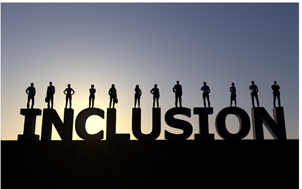Deaf Accessibility 101: Simple Steps to Improve Inclusion at Work
Imagine walking into the office and not being able to understand what’s being said—or having no way to ask a simple question. That’s the daily reality for many Deaf and hard-of-hearing individuals. But with a few intentional changes, your business can become a model of inclusion and Deaf-friendly business practices.
Why It Matters
Becoming a Deaf-friendly, inclusive workplace doesn’t just enhance the lives of Deaf employees and clients—it strengthens your entire organization. The Deaf and hard-of-hearing community in the U.S. is large and diverse. Over 48 million Americans have some degree of hearing loss, including individuals who identify as Deaf, hard-of-hearing, late-deafened, or DeafBlind. This population crosses all racial, cultural, and age lines, and communication preferences vary widely—from American Sign Language (ASL) to lip reading, speech, written English, or assistive technology. There is no one-size-fits-all solution—true accessibility requires intentional inclusivity.
Compliance and Beyond
Workplace accessibility isn’t just a best practice—it’s a legal requirement under the ADA, which mandates that employers with 15 or more employees and most public-facing businesses provide equal access to jobs, goods, and services. Federal agencies are governed by the Rehabilitation Act of 1973, particularly Sections 501, 504, and 508, which ensure non-discrimination in employment, programming, and technology.
But ADA compliance isn’t the end goal—it’s the starting point. Whether you’re a business or a government agency, creating a space where people feel respected, included, and heard makes a real difference.
Organizations that prioritize accessibility training and practices see happier teams, stronger community trust, and a better reputation. For businesses, that means loyal customers. For public agencies, it means better service and public confidence
Practical Steps to Become a Deaf-Friendly Workplace
- – Provide Deaf Awareness training for managers and customer-facing staff. These sessions help build respectful communication habits and reduce unintentional bias.
- – Train employees on the basics: maintain eye contact, face the person when speaking, and never shout. Clear communication and respectful body language go a long way.
- – Always speak directly to the Deaf person, not the interpreter. Avoid phrases like “Tell them…” or “Can you ask them…”—address the person directly, just as you would with any other colleague.
- Offer ASL interpreting services, onsite and/or virtual. At minimum, provide interpretation for all meetings, training sessions, and performance reviews.
– Consider on-call interpreting where an interpreter is available throughout the workday. On-call interpreting is designed to accommodate spontaneous or impromptu communication needs. - – Captioned training videos are essential, especially for onboarding, or safety materials. Keep in mind, however, that captions alone may not meet the needs of every Deaf person—interpreting services should also be available where appropriate.
- – Promote an accessible workplace culture rooted in equity. Encourage feedback from Deaf employees and community members and respond with action.
- – When in doubt, consult with experts. Accessibility consultants, Deaf-led organizations, or interpreting agencies like DAS can guide you in building sustainable, inclusive practices.
Creating a Deaf-friendly workplace isn’t just about legal compliance—it’s about leadership, empathy, and vision. The changes you implement today will open doors for Deaf individuals

